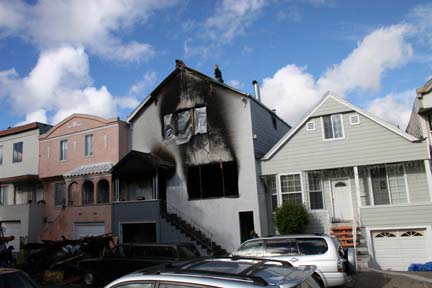
 |
|
|
Union links cutbacks to fatal fire Firefighters contend station ‘brownouts’ may be putting lives at unnecessary risk
|
|||||
| By Ilene Lelchuk, Charlie Goodyear, Chronicle Staff Writers Reprinted from The S.F. Chronicle, December 30, 2004 |
|||||
| A 78-year-old man died in a house fire in San Francisco’s Bernal Heights neighborhood Wednesday morning, less than a mile from a firehouse that was without an engine and had fewer firefighters than usual because of budget problems.
Fire officials say rescue crews were on Wednesday’s scene within minutes, but firefighter union leaders who are fighting cost-saving measures at the department question whether lives were endangered unnecessarily. Anthony Moro, who lived in the three-story house on Precita Avenue, perished in the blaze that consumed the wooden structure and displaced seven other residents. Moro’s death has quickly become part of the heated debate over so-called “brownouts” — San Francisco’s budget-reducing program that takes fire trucks and engines out of service at up to four stations a day. The department faces a $7.5 million cut and more brownouts as Mayor Gavin Newsom tries to trim $97 million from the city’s budget over the next 18 months. San Francisco’s firefighters union launched an ad campaign last month claiming the cuts could cost lives. Wednesday’s fatality, as well as two major fires Monday night, intensified the controversy. Fire Department officials say firefighters responded Monday just as quickly with other engines, but Joe Moriarty, vice president of San Francisco Fire Fighters Local 798, questions whether lives could have been saved any faster if the brownout weren’t in effect. The call from Precita Avenue came at 7:11 a.m. Wednesday, said Fire Department spokesman Pete Howes, and the first fire engine arrived within 2 1/2 or 3 minutes. The controversy, however, is that the nearest engine company, Station 9 at Jerrold Avenue, was browned out, down an engine equipped with a water pumper. When firefighters call in sick, instead of paying overtime to other crews to fill their shifts, the department takes up to four companies out of service for 24 hours at a time. So on Wednesday morning, the nearest fully staffed station was Station 11 at 26th and Church streets, and it responded first, Howes said. Stations 11 and 9 are almost equidistant from the blaze. Next to arrive were Engine 7 from 19th and Folsom streets and Engine 37 from Wisconsin Street in Potrero Hill. In all, eight engines and 60 to 70 firefighters responded to the two-alarm fire. Crews rescued a woman trapped on a second-story balcony and knocked the fire down in 30 minutes, Howes said. But Moriarty said the loss of one local engine Wednesday had created a domino effect that forced engines from farther neighborhoods to drive to the fire and might have slowed some response times. “We’re saying we still met our response-time goal,” Howes said. Still, fire officials and the mayor have said they are studying the response times. The neighbors at Precita Avenue said the engines seemed to arrive instantly. “As soon as we got out of our house, there were three or four fire engines — they were already there,” said next-door neighbor Celia Gonzalez. She said her mother had awakened her up after hearing an explosion. The union is keeping its own score. Moriarty said two other fires might have worsened Monday night because of brownouts. An 11 p.m. blaze at Washington and Lyon streets in Pacific Heights became a two-alarm fire while engines were en route, he said, and then there was a three-alarm fire at about midnight on 36th Avenue at Clement Street in the Richmond District. Engine 10, based at the station at Presidio Ave. and California Street, which was near the first fire, was out of service because of low staffing. Firefighters had to come from all over the city, including North Beach, Moriarty said. Reprinted from The S.F. Chronicle, Dec. 30, 2004 |
|||||
 |
|||||